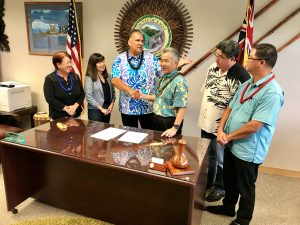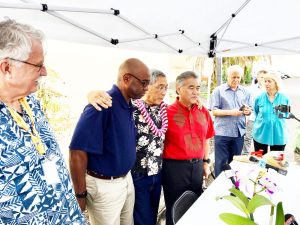
Gov. Ige, Kaua’i Mayor Bernard Carvalho and legislators meet on the release of flood recovery funds.
From temporary shelters to FEMA relief centers, farm loans and state and federal aid of all types — the message to disaster survivors on three islands is clear: “You’re not alone.” Governor Ige, the federal government and a multitude of state and county agencies have mobilized to offer support — on the ground and in person as thousands of residents try to rebuild their lives after devastating floods and the on-going Kīlauea eruption.
Since the April floods on Kaua‘i and O‘ahu and the continuing volcanic activity on Hawai‘i island, the governor has criss-crossed the state to assess the damage and ensure residents get the help they need. Among the latest news on disaster relief:
• A Federal Emergency Management Agency (FEMA) Disaster Assistance Center opened in the Kea‘au High School gym on the Big Island to serve as a “one-stop shop” for disaster survivors. FEMA assistance can help with temporary housing expenses, home repairs and disaster–related needs not covered by insurance. Representatives from state and county agencies that deal with social and mental health services, taxes and unemployment as well as the U.S. Small Business Administration, Veterans Affairs and the Red Cross are also there.

HI-EMA’s Tom Travis, FEMA’s Willie Nunn and Big Island Mayor Harry Kim gather as Gov. Ige announces more state aid.
• The governor’s second request to FEMA has been approved for individual assistance to Kaua‘i and O‘ahu residents who suffered losses in the wake of the April floods. At least 760 homes were impacted by the storm, including 187 that were destroyed or suffered major damage.
• A flood recovery bill signed by Governor Ige allocated $100 million to repair roads, bridges and public facilities on Kaua‘i and $25 million for repairs on O‘ahu. Another $12 million was released to Hawai‘i County to help with mounting costs of emergency supplies and temporary shelter-related services. “This will help the county protect the health and safety of residents,” said Governor Ige. Mayor Harry Kim added, “We have had tremendous support from the governor and his departments from the get-go.”
• Hawai‘i Army National Guard soldiers and community volunteers are working together to build an emergency community of temporary micro-housing units for seniors over age 60 and families with children under 18 left homeless by the lava flow. It’s hoped the “village” on the grounds of Sacred Heart Church in Pahoa could be the first of others from faith-based groups who want to help people who have been living in shelters after losing their homes to the eruption.
• The state Department of Agriculture is making available emergency loans of up to $500,000 and microloans of up to $25,000 for farmers who suffered damage to their crops on the three islands. “It’s painful to see all the damage to our crops and businesses caused by these natural disasters,” said the governor. “Our HDOA’s agricultural loan program will do its best to help our farmers and ranchers get back in business as soon as possible.”